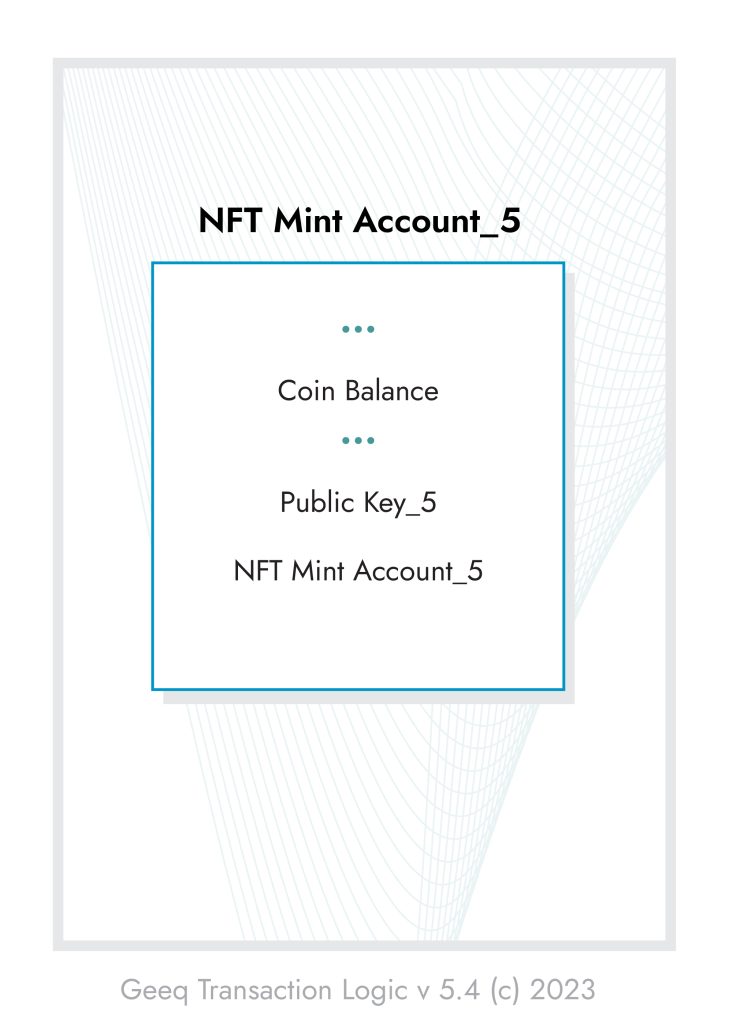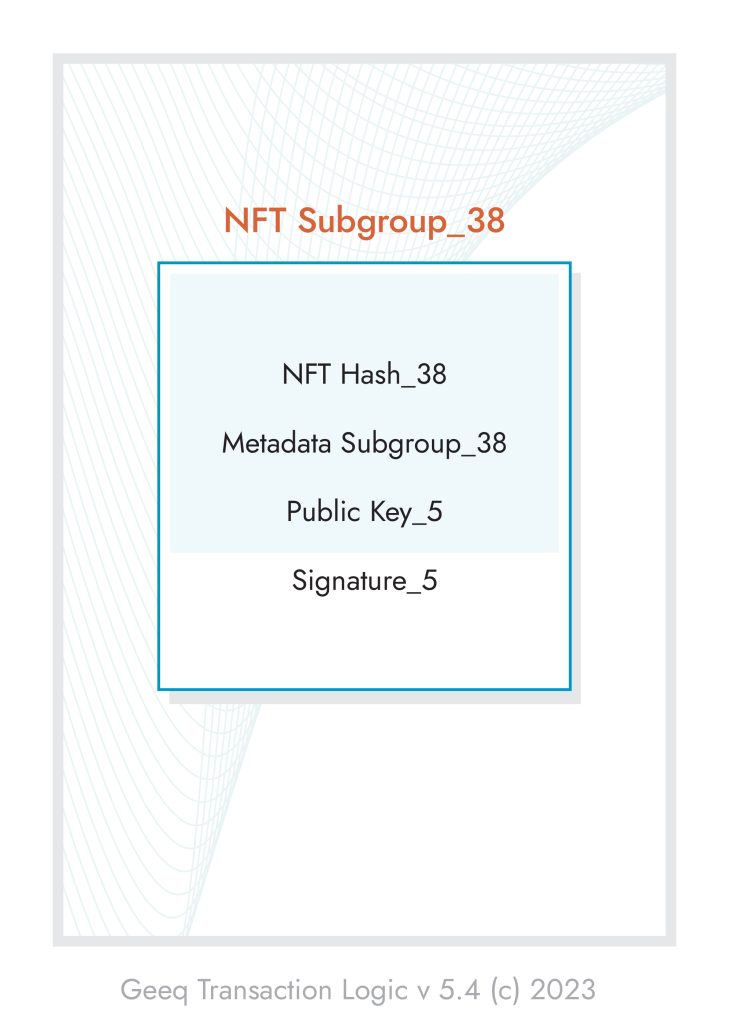By: Geeq on Apr 27, 2024
What is a Geeq NFT?
A Geeq NFT is a user-defined, unique, on-chain asset. It consists of two parts: (1) a deed to convey ownership and (2) a description of the asset.
Anything can be tokenized as a Geeq NFT: a digital file, a piece of data, a permission, and a real world asset.
Geeq’s two-part construction makes it easy to verify (1) the history of ownership by following transfers of the deed from account to account and (2) the authenticity of the NFT, because the deed is the only asset that points to the NFT’s description.
As a result, participants know exactly what they are trading and its provenance.
Keeping track of who has what, when, is an essential concept for blockchain applications. If you are uncertain about any link in the chain-of-custody, the entire value proposition falls apart.
Geeq’s patented protocol provides clear proof of ownership and authenticity every step of the way. If you care about counterfeits, supply chains, information supply chains, data integrity, following authorizations up the chain of command, or defining permissions for the use of your data, Geeq NFTs are for you.
The reason to put these records and transactions on-chain is to preserve them permanently and beyond doubt. The unparalleled security of Geeq’s protocol shields these blockchains from manipulation, so the data cannot be changed as if it were in a spreadsheet or ordinary computer file.
You also have the benefit of being able to prove your ownership directly with a 1 Kb receipt. Using Geeq is easier than saving papers, more reliable than depending on a centralized service that can be infected or bricked by a cyberattack, and more trustworthy than the error-prone methods used by other blockchains.
The next generation of apps.
Minting a Geeq NFT may be done via an app, mobile app, or dashboard.
You can customize the user experience within your app. By providing a standard service, minting a NFT can become as easy and familiar as the check-out process on a website.
Geeq APIs are available to connect the app to a blockchain running Geeq’s protocol.
Step 1. How to create a Geeq NFT mint on a public chain.
Every account on a public chain must be funded with $Geeq for transaction costs and controlled by a PPK (public-private key) pair. Transactions on private chains may be financed in other ways.
From the user’s side the flow for creating a NFT mint account is exactly like creating an ordinary account.
- Through an app, the user chooses the option to “create NFT mint”.
- The user’s wallet generates a new public-private key pair for the mint account.
- The app prompts the user to send the new public key with the “create NFT mint” transaction.
- The app prompts the user to authorize deductions of $Geeq to fund the new account and pay transaction fees.
- The user signs the transaction with their existing account’s private key, finds an honest node, and sends the request to that node. In other words, the user signs and sends the transaction through a user client (like an email client) to the blockchain.
What happens next?
If the transaction is valid, a record for the new mint account is generated in the account ledger. The mint account record displays the public key for that account, as shown below:

From that moment on, every NFT created by NFT Mint Account_5 must be signed by its Private Key_5.
A public entity who cares about its reputation, such as a financial institution, brand, or artist has the incentivize to advertise its public key(s) to its mint(s). A NFT issued from any account not controlled by the advertised public-private key pair(s) is immediately identifiable as a counterfeit.
This process is hard coded to work the same way each time. Smart contracts are not used to create a mint or mint a NFT. Geeq’s choice to codify a universal standard eliminates risks of exploits, dependencies on off-chain data, changing standards, and concerns over continued support.
Geeq de-risks tokenizing assets on-chain.
Step 2. How to Mint a Geeq NFT.
If a user controls a NFT mint account on a chain, the user may return to mint NFTs through all apps, mobile apps, or dashboards able to communicate with that chain.
Geeq is designed so the user experience is as easy as interacting with a website.
Imagine the possibilities for UI/UX while (1) securing your transactions without depending on central points of failure or (2) exposing your data to unauthorized viewers.
Have you tried the Geeq Data attestation app yet? If so, how would you monetize it?
Back to minting a NFT:
- Through an app, the user chooses the option to “mint NFT”.
- The app prompts the user to upload the hash of the file associated with the new NFT.
- The app prompts the user to enter metadata, e.g. notes, pointers to other databases or transactions, or tags for search.
- The app prompts the user to provide the mint’s public key.
- The app prompts the user to designate a receiving address for the NFT.
- The app prompts the user to authorize a deduction of $Geeq for the app’s fees.
- When the user is satisfied, they sign the “mint NFT” request with the mint’s private key, find an honest node, and send the request to that node. In other words, the user signs and sends the transaction through a user client (like an email client) to the blockchain .
Notice the user defines the NFT by entering pure data. No smart contracts are used. As a result, Geeq NFTs cannot be malicious because there is no smart contract code to execute. A Geeq NFT cannot drain your wallet.

What happens next?
To send a valid “mint NFT” transaction the user must sign the transaction which includes the data elements that describe the NFT (shown above as the shaded area of the NFT Subgroup). The use of the correct private key uniquely identifies the issuing account and locks the description of the NFT.
The use of the correct private key uniquely identifies the issuing account and locks the description of the NFT.
If the transaction is valid, the protocol executes the “mint NFT” transaction:
- A deed is created to represent ownership of the NFT. It is assigned a unique IRN (identification record number). The deed is sent to the designated address. The transaction is written in a block.
- A record is created in the corresponding Application Layer Ledger (ALL) which is a data counterpart to the ordinary account ledger.
Notice chain of custody is established from the beginning. The NFT Mint Account’s signature (the ISSUER) is recorded in the deed and its transfer to the first owner is recorded in the block. As soon as the NFT is minted, an authorized and knowledgeable viewer may use a block explorer to discover its provenance.
Every subsequent transfer of ownership is executed by transferring the deed from account to account. Exchanges of assets between accounts do not touch descriptions of the NFTs.
Geeq’s protocol provides a foolproof, trustless way to change ownership while ensuring the authenticity and uniqueness of the NFT.
Summary.
Geeq’s NFT technology is the most secure and straightforward way to define any on-chain digital asset. Specifically:
- The owner of the deed can be easily proven for any moment in time. The state of the NFT does not depend on smart contracts or hidden dependencies, and transactions at Geeq are validated in the order they were received.
- The deed points to the signed description of the NFT, recorded in the Application Layer Ledger. The entire on-chain history of the asset’s description is available. There are no data availability issues.
- The validity of the mint transaction can be proved (or disproved) independently and immediately. When NFTs represent assets of critical importance, it will not be enough to rely on confirmations from trusted sources. Nor will it be acceptable for proofs to be expensive and/or delayed.
- If the mint transaction was valid, the description the deed points to is also valid.
- The authenticity of the NFT can be verified against any original file (by hashing the original file and comparing it to the NFT record).
- Counterfeits are identifiable because they will not be minted or issued from the official accounts. A quick search with a block explorer resolves those issues.
Geeq’s no-smart contracts, data-agnostic protocol is perfectly suited to tokenize and secure all real world assets and critical data. Between Geeq’s NFT and attestation services, it is possible to achieve clarity – and proof – for activities that would otherwise require trust that the data have not been compromised or may not be recoverable in their original state.
Interested in details about our token?
Join Us For a ChatTo learn more about Geeq™ follow us:
Website ~ Grab a Coffee ~ http://www.geeq.io/news/
Telegram ~ Join us for a chat ~ https://t.me/GeeqOfficial
Twitter ~ Keep up to date ~ https://twitter.com/GeeqOfficial
YouTube ~ Feast your eyes ~ https://www.youtube.com/c/GeeqOfficial






To learn more about Geeq, follow us and join the conversation.
@GeeqOfficial